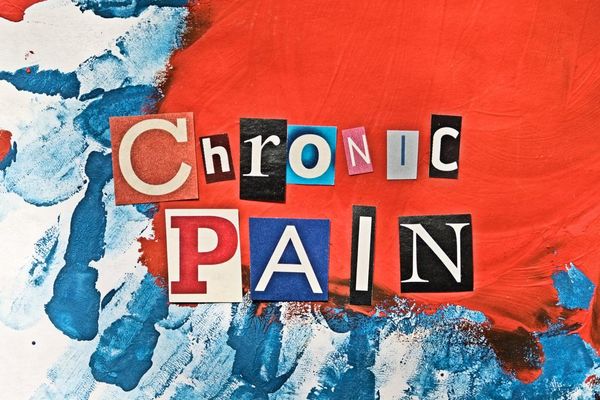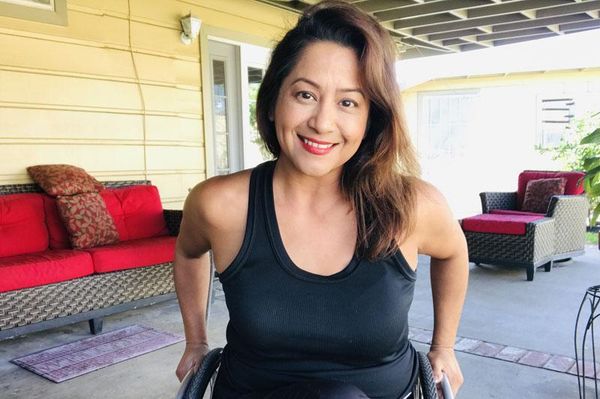Cindy Steinberg was seriously injured in an accident 20 years ago, but she still lives with pain every day. "I didn't know there was such a thing as living in pain all the time," she said.
When Steinberg had to stop working because of her pain, she started an informal pain support group at a local library and soon realized she was not alone. She met hundreds of people with all kinds of conditions — from endometriosis to chronic migraine, spinal stenosis to Ehlers-Danlos syndrome. Regardless of the original cause of pain, Steinberg realized the experience was often the same: devastating.
"Pain can affect every aspect of people's lives when it's chronic like this," Steinberg said. "I don't think it is really understood how severe that can be."
After seeing the impact chronic pain had on her and so many others, Steinberg left her corporate job and started a new career to try to make a difference. Now, she's the national director of policy and advocacy at the U.S. Pain Foundation and a member of HealthyWomen's Chronic Pain Advisory Board.
One in five Americans lives with chronic pain, according to the Centers for Disease Control and Prevention (CDC). Some groups suffer at higher rates, including women (22%), people in rural areas (27%), and people living at or below the poverty line (26%).
CDC data show that nearly 20 million Americans live with "high-impact" chronic pain, defined by the International Association for the Study of Pain as pain that limits life or work activities on most days for at least six months. Of those 20 million Americans, more than half (11.3 million) are women. Only 26% of people with high-impact pain are employed; nearly 68% are unemployed even though they previously worked.
People with chronic pain often also experience anxiety and depression.
In an email exchange, Ann Quinlan-Cowell, clinical nurse specialist at New Hanover Regional Medical Center and a member of the HealthyWomen Chronic Pain Advisory Board, wrote, "Chronic pain impairs the quality of life and health (physical, emotional, mental, spiritual) of women and those in vulnerable populations."
The burdens of living with chronic pain are widespread and complex, and structural reforms to improve the treatment of pain are badly needed. The SUPPORT Act (Substance Use-Disorder Prevention that Promotes Opioid Recovery and Treatment for Patients and Communities Act), which was designed to curb overuse of opioids but also to strengthen clinical guidelines and expand treatment options for people living with pain, was introduced none too soon.
Making progress with SUPPORT
When Congress passed the SUPPORT Act in 2018, it took important steps toward improving the treatment of pain, as well as addressing the opioid epidemic.
Using a public health — rather than a punitive — approach, the act sets prescribing guidelines to reduce reliance on prescription opioids and requires the U.S. Food and Drug Administration (FDA) to develop opioid prescribing guidelines for acute pain. The act also supports research and development of nonopioid alternatives to treating pain and public education about opioid risks and alternatives.
Despite important progress, the act hasn't been fully implemented by relevant agencies, including the FDA and the National Institutes of Health (NIH).
"We appreciate the magnitude of the tasks facing the agencies, but given the long-term importance of the needs for better pain treatments, we continue to urge the FDA and NIH to appropriately prioritize work in this area," said HealthyWomen CEO Beth Battaglino, RN-C. "We believe that there is an absolute need to develop and make multiple treatment modalities available, including nonaddictive and nonpharmacological interventions for chronic pain."
Federal agencies must pick up the pace on implementing the act's key components, including encouraging public dialogue, conducting research, setting treatment guidelines and developing individualized treatment approaches:
Encouraging public dialogue
"The act has further enabled conversations not only within the agencies but in Congress as well on the important focus on treatment of pain and how to prevent opioid use disorder and the misuse of opioid medicines. This must be done while also recognizing that opioids may be appropriate for certain patients when alternatives are inappropriate or contraindicated," Battaglino said.
These conversations must continue — and accelerate.
Battaglino urges federal agencies to gather more public input at local and regional levels to guide its actions.
"Patient perspectives are often unique and unknown to regulators," she said. Gathering this information will help the FDA and NIH design research requirements that can offer clarity and predictability on treatment options for patients and providers.
Conducting research
Despite extensive pain research, there are still many unknowns about underlying pain mechanisms and population differences. The FDA and the NIH should consider how genetic, sex and age differences affect people's experience of pain and what treatments may bring relief.
Setting treatment guidelines
Clinical guidelines and education for healthcare providers are also essential.
"Physicians get very little education on pain in medical school and feel ill-equipped to manage pain problems that are often complex without easy answers," Steinberg said. "They have gotten a strong message not to prescribe opioids and often don't know what else to do."
Ideally, healthcare providers would use an integrative, collaborative approach with patients, according to Quinlan-Colwell. Unfortunately, patients, especially vulnerable ones, rarely get that level of care, she added.
Evidence-based guidelines will help providers care for patients with pain and ensure that patients get the standard of care they deserve.
Guidelines for treating acute pain may also help prevent future problems. "The absolute best way to prevent acute [pain] from becoming chronic pain is to well manage acute pain using a multimodal approach," said Quinlan-Colwell.
Developing Individualized treatment approaches
According to Penney Cowan, founder and CEO of the American Chronic Pain Association and a HealthyWomen Chronic Pain Advisory Board member, the act addresses the needs of many underserved and underrepresented populations and takes into account behavioral health needs. "That tells me [the authors of the act] are looking toward a more balanced approach to pain management."
But fully implementing the act — which will require congressional oversight to hold agencies accountable — is critical to ensuring the development of new, individualized approaches for treating pain, particularly nonopioid medicines.
"There's no magic bullet," Steinberg said. "Everybody is an individual, and people have to combine a number of different modalities to manage their pain."
Developing new approaches — and covering a wide range of treatment options — has the potential to help people living with pain while preventing and treating opioid use disorder.
Patients’ voices matter
To spur the agencies to action, patients living with pain should become advocates.
"Nothing really happens unless advocates speak out for change," Steinberg said.
She encourages people to speak up about inadequate treatment they receive. She suggests calling or emailing members of Congress or state representatives to demand better care.
"One person can make a difference," she said. "If people were more vocal about these real facts regarding pain, I think pain care would improve."
Concretely, chronic pain patients and their allies can advocate for the pain provisions in the SUPPORT Act to be implemented. The act has the potential to improve our understanding of pain through basic research, standardize treatment guidelines and expand treatment options. These changes could bring relief to millions of Americans living in pain — but only if implementing the act becomes a priority.
This resource was created with support from Pfizer.
- Chronic Pain Is a Disease — and It Should Be Treated Like One ... ›
- A Call to Action for Women in Chronic Pain - HealthyWomen ›
- Chronic Pain for Women Is Real - HealthyWomen ›
- Chronic Pain ›
- Chronic Pain Drove Me to Despair, Cancer Taught Me to Heal - HealthyWomen ›
- How I Healed From the Trauma of Chronic Pain - HealthyWomen ›







